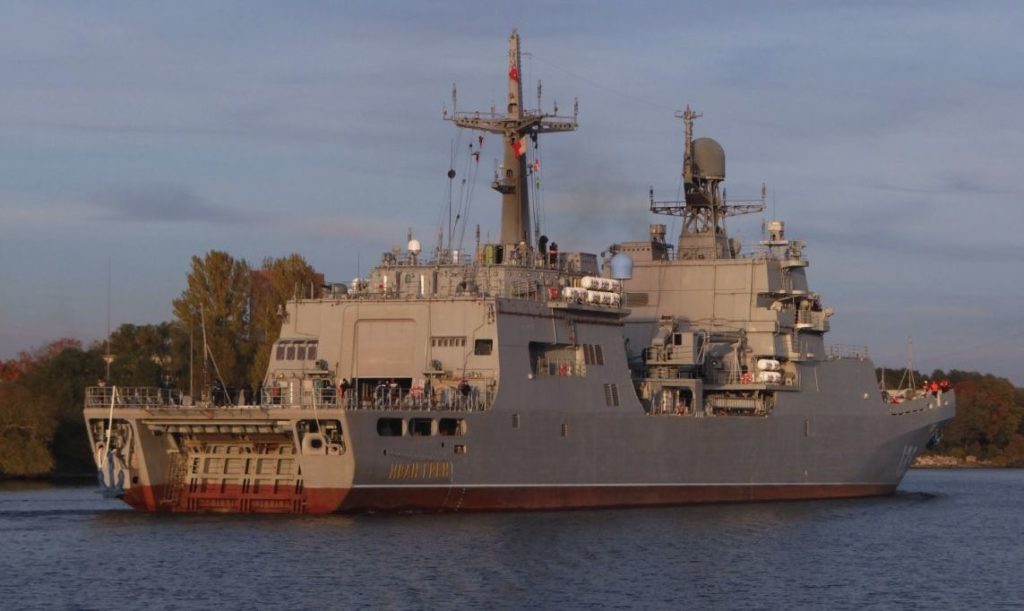Written by Alex Gorka; Originally appeared at strategic-culture.org
Naval infantry units from the Black Sea Fleet and the Northern Fleet have been carrying out important missions in Syria, such as providing security for the Russian naval base in Tartus. The Marines with their BTR-82 APCs have supported the Syrian Arab Army in many operations on the ground. Syria has been a testing ground for this branch of the Navy. Russia’s military operation in Syria highlighted the need for more ships capable of cargo delivery and landing operations. Some steps are taken to boost the Russian Navy’s amphibious capability.

Ivan Gren large landing ship (Project 11711), the first vessel of the class, has started state sea trials. She sailed to the Baltic Sea on Nov.30. The new ship increases the power projection capability being able to land ground forces onto an enemy shore up to 4,000 kilometers from their home ports.
Amphibious landing operations are the primary mission. The ship can perform over-the-beach assault. Ivan Gren can be also used for logistical transport of military vehicles and cargo. In peacetime, the Project 11711 class can be engaged in humanitarian operations.
With a full load displacement of 6,600 tons, the landing ship is able to carry up to 13 main battle tanks or 36 armoured personnel carriers and up to 300 marines. Number-in-class: 2. The hull of the second unit of this project, Pyotr Morgunov, is under construction. It was laid down in the Kaliningrad shipbuilding factory Yantar and is expected to be launched in 2018.
The Russian Navy originally planned to commission six such ships, but in 2015 it was announced that their number will be reduced to two in favor of a new, larger generation of landing ship, which will be able to carry several helicopters. It will have a displacement of 14-16,000 tons, and be able to carry 500-600 marines or six helicopters, and landing craft.
The Ivan Gren’s Ro-Ro design allows the armor vehicles to move by the tank deck from bow to stern ramps. To perform over-the-beach assault the ship uses bow doors with internal ramp to disembark vehicles. Also there is a rear ramp which is used by onboard fast landing craft. A total of 2 or 3 landing craft are carried by Ivan Gren. Instead of the landing force it can carry 1500 tons of cargo.
The vessel’s crew: 100 men, maximum speed: 18 kn, range: 3,500 nmi at an economic speed of 16k. A maximum endurance: 30 days. The vessel incorporates a mono-hull design, with a length of 120m, beam of 16.5m, hull height of 11m and a draft of 3.8m.
The armament suite includes Igla (SA-N-10 Grouse) man-portable surface-to-air missile (SAM) system, multiple artillery rocket systems, a 76mm AK-176 naval gun, and the AK-630M-2 close-in weapon system (CIWS). The latter is installed with two 30mm six-barreled GSh-6-30 rotary cannons with a rate of fire of 10,000 rounds per minute. The CIWS can engage targets within the range of 4,000m. All of these weapons can be used against land, surface and air targets as well as for close range defense against incoming anti-ship missiles. Also there are two 14.5 mm heavy machine guns. The ship may also accommodate multiple launch rocket systems. The Ivan Gren class is fitted with a countermeasures system, which launches decoys. This system reduces the chance of being hit by enemy missiles.
The ship has one helicopter spot on the deck and hangar that can accommodate two Ka-29 assault transport helicopters. The landing pad is located at the stern of the hull. These helicopters can land Marines ashore and support amphibious operations with their firepower. The Ka-29 helicopters can be also used for utility transport and medical evacuation roles.
The amphibious ship is not a stealth vessel, but some measures were taken to reduce radar cross-section of the ship in order to make it stealthier to radars. The sensors and countermeasures package includes MR-352 Pozitiv air/surface search radar, navigation radar, an electro-optical close-range air/surface situational awareness system and a decoy launching system.
Ivan Gren is powered by two DRRA-3700 diesel engines, developing 5 000 shp each. Power is delivered to two shafts. The vessel also integrates a PU100FM thruster and two ADG-1000NK diesel-generators.
As Russia asserts itself on the world stage, the projection capability comes to the fore, increasing the role of sea power. With Ivan Gren in service, the amphibious capabilities will be significantly strengthened, increasing the ability to project power and expand Russia’s influence in faraway regions.





